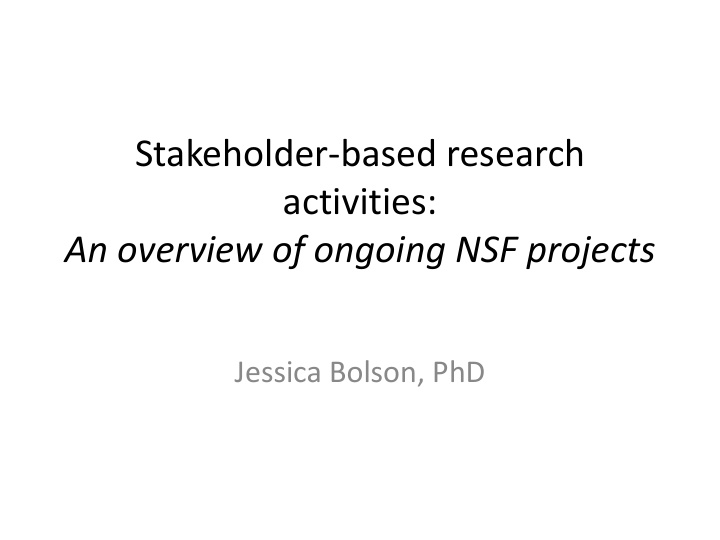



Stakeholder-based research activities: An overview of ongoing NSF projects Jessica Bolson, PhD
Research objectives UWIN SRN SFWSC • • Develop new information Develop new information on regarding transitions to economics of water sustainable urban water • Build a hydroeconomic systems optimization model • Build network of stakeholders • Use the model to simulate and and researchers across US evaluate tradeoff decisions • Understand adoption of water • technologies Understand how different • information leads to different Develop sustainable water blueprint based upon decisions among individual extensive stakeholder and groups of decision makers feedback
Purpose of Research-Stakeholder interactions • Provide input for research products Goals of • Test research stakeholder products based • To develop research relevant and usable science!
UWIN Stakeholder Engagement Goals Elicit active stakeholder contribution to research and outreach Build social capital through network development and measure with network analysis and pre-/post-meeting surveys Build inter-regional horizontal connections and capacity for information exchange Create “safe spaces” for innovation Develop Urban Water Sustainability Blueprint 4
Conceptual Framework for stakeholder based research (UWIN) Year 1. Year 4. Year 5. Year 3. Year 2. Building the Best Presenting Developing Understand network and management updated actionable decisions learning practices and Blueprint and science about Blueprint extend the concerns development network
Annual Stakeholder Meetings • Same core team responsible for facilitation and data collection at all regional meetings • Host urban area research team participates • Core cities: o Baltimore, MA o Miami, FL o Denver, CO o Phoenix, AZ o Los Angeles, CA o Portland, OR
Meetings Research Arc • Year 1: Build the network and learning about concerns Year 1 Goals o Build network cohesion o Establish clear objectives to foster participation o Identify challenges in urban water management o Inventory existing water sustainability projects o Survey Focus: Gather project data
Meetings Research Arc • Year 2: Understand decisions Year 2 Goals o Enhance understanding of regions’ water sustainability decisions o Focus discussions on decisions and barriers to implementing sustainability strategies o Survey Focus: Gather data on decisions
Meetings Research Arc • Year 3: Develop actionable science: Year 3 Goals o Presentations on science o Case studies from other cities o Focus discussions on adapting information to host city o Survey Focus: Barriers to using science and perceptions of usability
Meetings Research Arc • Year 4: Best management practices Year 4 Goals o Collaboratively identify best management practices Technical Communication, implementation, adoption strategies o Discuss draft Blueprint o Survey Focus: Understanding best management practice
Meetings Research Arc • Year 5: Present updated Blueprint and Extend the Network : Year 5 Goals o Vetting of integrated Blueprint o Survey Focus: Network extension and sustainability
Ongoing network engagement • Develop strategy for maintaining engagement of network members • Water Sustainability Hub for knowledge management 12
SFWSC Stakeholder Engagement Goals Elicit stakeholder input and use prior research in HEO model development Build understanding of the value of ecosystem services through surveys and incorporate information into model Develop understanding of the effects of different sources and types of information Conduct behavioral research using tools developed Develop policy recommendations
Conceptual Framework for stakeholder based research (SFWSC) Contribute to model Develop research tools and Ethnographic Research development and test model questions outputs • Drivers of decision making • Survey tools (residents & • Provide inputs for model anglers) • How decisions are made • Test model outputs with • HazSim (household scale) stakeholders • Who makes decisions
Three Pronged Approach Ethnographic Research Interviews Observations (Local and regional (Meeting stakeholders, attendance/ NGOs, participation in developers, and climate focused tribal working groups) representatives ) Preliminary results: -Barriers & bridges in shift from adaptation planning to implementation identified -Avenues for inputs of science & policy action opportunities characterized -Critical concerns for regional stakeholders better understood
Surveys conducted
Surveys conducted : HazSim – A general programming platform allowing rapid development and deployment of Information Acceleration experiments. Users access information via a virtual living room computer, television, cell phone, and individuals, and data includes all click sequences, durations, and survey responses. Temporal Orientation Information Gathering Decision Module (Acceleration) Module
Ongoing research HEO Model HazSim 2 Development Opportunities for stakeholder input Sustainability ??? Blueprints
• Information testing: how might different types & sources of information lead to different decisions? • Developing different iterations of HazSim • Exploring model runs and outputs – Tradeoff analyses – Scenario analyses and discussions • Blueprint development – Development of something useful across regions
Thanks! Questions?
Discussion (20 minutes) • Impressions? Potential roles in these projects? • Avenues for participation? • How to engage regional stakeholders and organize the meetings? • Interest in participation? • Interest in national level study and/or cross city comparisons?
Activity (40 minutes) • How can we incorporate the perspectives of utilities, managers, suppliers in our model? – What are the primary linkages between utilities, suppliers and regional water allocation? – What affects utilities’ operating costs? – Any additional recommendations for economic section of model? – What comes to mind when considering different future land use scenarios? – What are the implications of the climate scenarios presented?
Recommend
More recommend